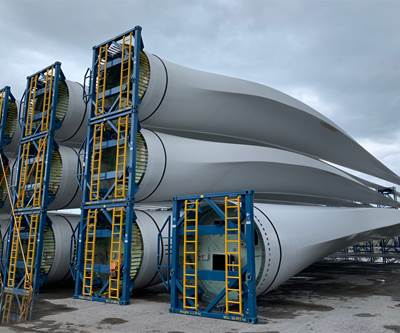KiMuRa project welcomes composites manufacturers to join recycling effort
Exel Composites, alongside industry partners, transform composite waste into cement through co-processing. Incentivizing participation aims to improve project scale and effectiveness.
The KiMuRa project was initiated in December 2020 by Finnish Plastics Industries Federation, the Ministry of the Environment, Kuusakoski Oy, Finnsementti Oy and seven composite industry companies, including Exel Composites (Vantaa, Finland) to develop a circular economy model for composite products. With secured funding, the partners sought to implement open-loop recycling techniques to transform composite waste into cement through co-processing, though challenges have remained. Recently, they are offering a more inclusive approach to joining this effort, encompassing not only manufacturers but also any business generating composite waste during its production processes.
KiMuRa’s co-processing method involves the shredding and crushing of the waste to break fiberglass composites down into more manageable pieces. Subsequently, the prepared composite waste is introduced into a cement kiln, where each constituent element of the glass contributes to the formation of cement clinker, an essential intermediary in cement production. Additionally, co-processing enables energy recovery, as the organic components in the resins generate heat energy during combustion, reducing the reliance on fossil fuels in cement kiln operations.
Cement clinker formation conventionally relies on two primary materials: limestone (calcium carbonate) and aluminum silicate clays like kaolinite. These materials undergo a chemical reaction to produce alite, the key component of cement clinker. In the co-processing method, glass fibers serve as a replacement for both limestone and kaolinite — in fact, the composite’s composition, approximately 50% silicon dioxide, up to 15% aluminum oxide and 20% calcium oxide, make it an effective alternative for both substrates in cement clinker production.
The incorporation of the resin component of the composite in cement production serves to substitute traditional fossil fuels like coal and coke, alongside other solid recovered fuels (SRF). The carbon and hydrogen composition of these elements gives a high calorific value, making them efficient fuels for industrial processes. During combustion, both the SRF and composite resins undergo exothermic reactions, releasing heat that facilitates the high-temperature processes crucial for clinker formation in cement production.
KiMuRa partners note that this process offers significant environmental benefits:
- It effectively addresses composite waste production, diverting it away from energy recovery solution and/or landfills.
- Co-processing generates no ash residue, further minimizing environmental impact.
- The composite waste’s mineralized components, such as glass fiber, serve as substitutes for traditional raw materials in cement manufacturing, reducing the need for mining and extraction operations.
However, despite the strides made by the KiMuRa project, challenges remain. Currently, the entire Finnish composites industry produces about 2,000 tons of scrap annually, a fraction of the cement processing plant’s capacity, which reportedly stands at 10 of times that amount. The processing plant eagerly accepts as much composite scrap and waste as possible; the limited supply hampers the project’s scale and effectiveness.
Despite this, manufacturers still express concerns about the financial implications of participating in the initiative. The costs associated with transporting, crushing and processing composite waste are increased compared to traditional waste management. To incentivize participation, the companies involved in the project so far have agreed that any company willing to join in this recycling route can do so without having to pay investments or the work done so far.
Moreover, to help address this challenge, Business Finland has committed €1.4 million to support the industrial continuation of the project led by recycling company Kuusakoski. This initiative aims to construct a state-of-the-art composite crushing and shredding plant. With advanced technology and streamlined processes, this facility promises to alleviate the financial burden associated with preparing composite waste for co-processing. It will consist of several covered conveyors, two shredders, a magnet for removing ferrous materials and a dust control system. By increasing efficiency and reducing costs, it will enable more composite manufacturers to participate in the consortium, further advancing the goals of the KiMuRa project.
Related Content
Bio-based acrylonitrile for carbon fiber manufacture
The quest for a sustainable source of acrylonitrile for carbon fiber manufacture has made the leap from the lab to the market.
Read MoreTU Munich develops cuboidal conformable tanks using carbon fiber composites for increased hydrogen storage
Flat tank enabling standard platform for BEV and FCEV uses thermoplastic and thermoset composites, overwrapped skeleton design in pursuit of 25% more H2 storage.
Read MoreManufacturing the MFFD thermoplastic composite fuselage
Demonstrator’s upper, lower shells and assembly prove materials and new processes for lighter, cheaper and more sustainable high-rate future aircraft.
Read MorePlant tour: Joby Aviation, Marina, Calif., U.S.
As the advanced air mobility market begins to take shape, market leader Joby Aviation works to industrialize composites manufacturing for its first-generation, composites-intensive, all-electric air taxi.
Read MoreRead Next
Toray, Elevated Materials repurpose carbon fiber prepreg waste
MOU advances efforts to reduce waste, conserve resources and decrease pollution through upcycling of Toray’s composite material scrap.
Read MoreDecommissioned wind turbine blades used for cement co-processing
An initiative to recycle wind turbine blades includes the use of recycled glass fiber composites for cement manufacturing, replacing raw material and saving energy.
Read MoreThermolysis launches RCF brand supporting recycled carbon fiber product development
Taiwan-based company offers rCF product design and development with significant CO2 emission reductions and certified material traceability.
Read More



























